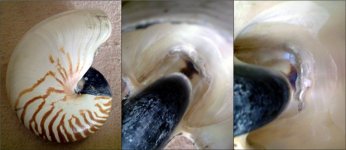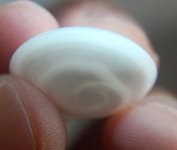You are using an out of date browser. It may not display this or other websites correctly.
You should upgrade or use an alternative browser.
You should upgrade or use an alternative browser.
Nautilus pearl
- Thread starter effisk
- Start date
SteveM
Well-known member
- Joined
- Jan 29, 2007
- Messages
- 2,040
Hopefully we will be able to obtain the shell and have it examined. It would be interesting to know if the 'intruder' is interred within the septum or if it was nacre-coated later. The mantle in that area is thought only to secrete nacre during septum construction, so this might have significant scientific value.
lisa c
Perpetual Pearl Student
- Joined
- Jun 28, 2009
- Messages
- 3,600
redX vs photo
redX vs photo
Yea!! So can I!
Of course, now I wonder what glories I missed by seeing only the Xs.
Hey, better some than none. I wonder what magic you performed.
This is edge of the seat stuff now!
redX vs photo
That's a beautiful photo, and yes, I can see it!
Yea!! So can I!
Of course, now I wonder what glories I missed by seeing only the Xs.
Hey, better some than none. I wonder what magic you performed.
This is edge of the seat stuff now!
Valeria101
New Member
- Joined
- Sep 7, 2006
- Messages
- 2,067
Talk about perfect timing! 
SteveM
Well-known member
- Joined
- Jan 29, 2007
- Messages
- 2,040
The new shell with blister is in hand. The blister is located in the final body chamber of a mature Nautilus, so it would have had a period of up to several years in which to form. I will be taking it to Peter Ward at the University of Washington for X-Ray and for his opinion regarding its potential for shedding light on biomineralization in the posterior (dorsal) Nautilus mantle.
Now let's circle back to a pivotal moment in this thread, about halfway through to this point:
We have just received GIA certificates with their official reports on quite a number of the pearls shown throughout this thread. That particular pearl has come back as 'NATURAL BLISTER PEARL, SALTWATER, SPECIES UNDETERMINED' (can’t blame them for cold feet at this point!).
This result gives added weight to my more recent post:
All shown pearls certified as natural saltwater, species 'undetermined.'
Now let's circle back to a pivotal moment in this thread, about halfway through to this point:
Separation of pearl and shell at origin was an unfortunate decision, however if the pearl were determined to be a blister pearl and not a fully formed pearl with a conveniently-photogenic attachment point, arguments would be strong in favor of authenticity. However, upon what now appears to have been an informal initial examination, GIA's Ken Scarratt determined that it was a button pearl with superficial attachment—not nearly as conclusive.18 pages later…
We have just received GIA certificates with their official reports on quite a number of the pearls shown throughout this thread. That particular pearl has come back as 'NATURAL BLISTER PEARL, SALTWATER, SPECIES UNDETERMINED' (can’t blame them for cold feet at this point!).
This result gives added weight to my more recent post:
Below are pearls from prior posts that most strongly come to mind when I think of Nautilus pearls. Top row is the infamous pearl reportedly found attached to a dry shell last November…
All shown pearls certified as natural saltwater, species 'undetermined.'
Last edited:
SteveM
Well-known member
- Joined
- Jan 29, 2007
- Messages
- 2,040
I am writing from a hotel on the Cuesta de Gom?rez in Granada, Spain in the shadows of the Alhambra. We've just spent parts of two days with the world-famous mollusk shell research team of Antonio Checa and Julyan Cartwright. Checa a paleontologist and biologist at the University of Granada, one of Europe's oldest, largest and most respected such institutions. Cartwright is a physicist and theoretician with specialty in natural orders.
To the point:
Under ESEM (environmental spectographic electron microscopy) Checa determined that the vortexed pearls, as well as those pearls I am most confident to be Nautilus (the ?blister? and the ?cooked? pearls in my recent summary post at Pearl-Guide), share in common an aragonite microstructure previously unobserved in pearls.
It will be a long process of discovery to confirm how this observation may relate to the attempt to verify Nautilus ID in pearls.
Stay tuned!
To the point:
Under ESEM (environmental spectographic electron microscopy) Checa determined that the vortexed pearls, as well as those pearls I am most confident to be Nautilus (the ?blister? and the ?cooked? pearls in my recent summary post at Pearl-Guide), share in common an aragonite microstructure previously unobserved in pearls.
It will be a long process of discovery to confirm how this observation may relate to the attempt to verify Nautilus ID in pearls.
Stay tuned!
Last edited:
Caitlin
Well-known member
- Joined
- Dec 11, 2004
- Messages
- 8,502
Brilliant! I am so impressed. This is the test to use for Nautilus!
Your intrepid research and reporting have pushed this to the point where you could locate the correct machine to do the examination and take your samples there. I think you have done the job of bringing Nautilus into the 21st century, with a way to positively ID it! It appears that nautilus is responding to the call. Good work...!
I am so glad you are recording this journey here on P-G. It is a privilege to read it here. This is the second, and more momentous, time Pearl-Guide members have uncovered info in a thread.
Are you going to write some kind of article about this? We will want to put up a copy in our News section.
Your intrepid research and reporting have pushed this to the point where you could locate the correct machine to do the examination and take your samples there. I think you have done the job of bringing Nautilus into the 21st century, with a way to positively ID it! It appears that nautilus is responding to the call. Good work...!
I am so glad you are recording this journey here on P-G. It is a privilege to read it here. This is the second, and more momentous, time Pearl-Guide members have uncovered info in a thread.
Are you going to write some kind of article about this? We will want to put up a copy in our News section.
Last edited:
CortezPearls
PG Forum Admin
- Joined
- Aug 26, 2005
- Messages
- 4,079
God's Magnificent Works...when Humans unravel Nature's Most Perplexing Questions we can find BEAUTY traced on every single crystal, in every fractal design. The complexity is mind-boggling, thus this knowledge becomes SACRED and the more we can appreciate what we have been allowed to observe and cherish.
Hallelu-Yah Indeed!!!
Thank you very much for sharing this incredible information with all of us here on the forum Steve
Hallelu-Yah Indeed!!!
Thank you very much for sharing this incredible information with all of us here on the forum Steve
SteveM
Well-known member
- Joined
- Jan 29, 2007
- Messages
- 2,040
I've approached this thread as a sort of living diary, with no idea where things would go. It is an already-written tale (admin: Don't lose it!!). The important writing must be left to the scientists and the journalists.Are you going to write some kind of article about this?
No comment, just wanted to memorialize those words!God's Magnificent Works...when Humans unravel Nature's Most Perplexing Questions we can find BEAUTY traced on every single crystal, in every fractal design. The complexity is mind-boggling, thus this knowledge becomes SACRED and the more we can appreciate what we have been allowed to observe and cherish.
Lagoon Island Pearls
Well-known member
- Joined
- Dec 8, 2009
- Messages
- 2,117
... with no idea where things would go.
It only gets better. An amazing and enviable journey!
SteveM
Well-known member
- Joined
- Jan 29, 2007
- Messages
- 2,040
Occasionally I have utilized circular links such as this when our winding road to Nautilus criss-crosses a particular stream of thought.Molluscus Abominabilis
I’ve continued to search for alternative explanations to Nautilus for the vortex structure in non-nacreous pearls. A prominent and respected internet source for fine and rare shells and occasional pearls posted a photo of a non-nacreous pearl showing spiral chatoyance pattern. I was able to procure the pearl and a specimen of its purported shell, the gastropod Fusinus Colus.
The post linked above followed great initial enthusiasm regarding the vortexed specimens, and threw considerable water upon the vortex/spiral feature as a potential visual marker for Nautilus.
During our ESEM session on Tuesday there was not enough time to look at this pearl. It was subsequently analyzed. Upon departing Granada we retrieved the pearl, and were told that its microstructure is consistent with the other vortexed pearls. However, this microstructure does not comply with the known microstructure of the Fusinus colus shell—or any known gastropod or bivalve for that matter.
Last edited:
SteveM
Well-known member
- Joined
- Jan 29, 2007
- Messages
- 2,040
This miraculous 'pearl from the eye of a Nautilus' was sold to a London jeweler and subsequently sent to GemLab for certification (my assumption based upon GemLab director Thomas Hainschwang's description of an odd specimen with 'swirl' received just prior to our meeting in Tucson last February).…below are photos received from Bali of a found Nautilus pearl together with its mollusk, and a closeup of the bottom of the pearl with that eyecatching swirl. I'm not anatomically adept is the pearl coming out of the animal's EYE?
These photos are from the same source as the blister posted by JNorris…
I assume it failed certification, as it has resurfaced on the seller's website.
This is a calcareous gastropod operculum (LINK to the authority on the subject), polished up a bit. The seller has reduced his price to a modest $20,000 US. But it is a full 30 carats.
Attachments
DrTKStern
Natural Pearl Connoisseur
- Joined
- Oct 29, 2007
- Messages
- 374
Nautilus Pearls
Nautilus Pearls
Hi, All,
I now have two Nautilus pearls with GIA cert. Societe des Perles Fines Natural Pearl Society will be posting photographs of both. www.NaturalPearlSociety.org
Sincerely,
Tom
Nautilus Pearls
Hi, All,
I now have two Nautilus pearls with GIA cert. Societe des Perles Fines Natural Pearl Society will be posting photographs of both. www.NaturalPearlSociety.org
Sincerely,
Tom
Similar threads
- Sticky
- Replies
- 12
- Views
- 1K
- Replies
- 2
- Views
- 708


